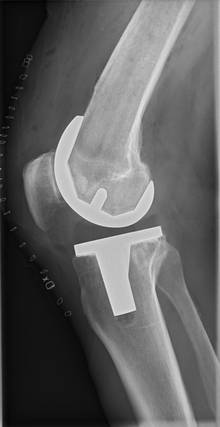INTRA-OPERATIVE DISINFECTION OF BONE PROSTHESIS
Description
The formation of bacterial biofilms in bone implants, such as prosthetic knee implants, is a post-surgical complication that leads to the chronification of infections, as well as the protection of bacterial colonies against antibiotics. Biofilms are generated, mainly, by the adhesion of microorganisms to the metal surfaces of the prostheses, and they contain enzymes that trap antimicrobial agents, which decreases the penetration of antibiotics, reducing their effectiveness.
In this invention, a device for intraoperative use has been developed, which performs an electro-disinfection process to reduce biofilm or bacterial infections in knee prostheses. The new system provides a terminal with an array of electrodes that is placed on the external surface of the prosthesis to be treated and a control system that controls the sequence and amount of energy applied through each of the electrodes. The device is used only during the time of the surgical intervention.
Advantages
The treatment of infections of bone prostheses is complex, long and expensive. Traditionally, it consists of washing and replacing mobile components in recent implant infections (between three and six weeks after surgery), using antibiotic-impregnated cements, and intraoperative irrigation. However, biofilm can maintain a hibernating state for long periods of time, which makes it significantly difficult to detect using traditional techniques. After the aforementioned initial period after surgery, the treatment of infections generally requires the complete replacement of the implant in a single surgery or, alternatively, a first replacement with a temporary component that, after a minimum period of six weeks , is replaced in a second intervention by a definitive implant. The first method has a success rate of between 50-55%, while the second increases to 70-90%. Despite this, in any of the cases, these methods have an enormous physical and psychological cost for the patient, in addition to a high economic cost, which in the case of knee replacements is estimated at around twenty billion dollars worldwide. , corresponding to infection between 1%-2% of cases, which means approximately three hundred thousand infected prostheses per year. Additionally, it should be noted that a significant number of infections are not resolved with these methods, which can lead to amputation or even the death of the patient. The most recent studies indicate that 5-year mortality after a prosthetic infection rises to 25.9%, compared to 12.0% in patients without infection.
The developed system does not require the use of special prostheses and is used only during an intervention for disinfection. Other related systems based on bioelectrical effects use modified prostheses or implanted electrodes.
Uses and Applications
The present invention falls within the medical sector and, more specifically, in orthopedic surgery. Its application is mainly focused on the prevention and intraoperative elimination of infections in knee prostheses, although without limitation to other types of prostheses or applications, through the application of low power electrical currents. Therefore, the market of potential interest is the manufacturers of medical equipment and knee prostheses.
Keywords
Sectors
Areas
Patent Number
ES2957331B2 Expediente
Applicants
UNIVERSIDAD DE MÁLAGA, JUNTA DE ANDALUCÍA. CONSEJERÍA DE SALUD. SERVICIO ANDALUZ DE SALUD (SAS), THE ROYAL INSTITUTION FOR THE ADVANCEMENT OF LEARNING / MCGILL UNIVERSITY
Inventors
ISKANDAR TAMIMI MARIÑO, JESUS MANUEL GOMEZ GABRIEL, AMALIA CRISTINA URDIALES GARCIA, FALEH TAMIMI MARIÑO, MARÍA GASCA
Filing Date
02/06/2022
Protection Level: National (Spain) and international
Processing Status: Spanish patent and international protection application








